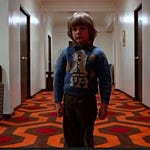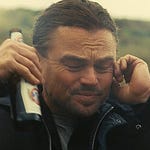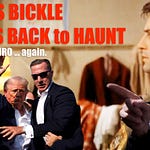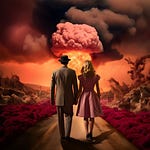When I look back on the best horror movies, I do so with sadness and a sense of mourning for what once was and may never be again. Just take the year 1982 when so many great movies hit theaters, like E.T., The Year of Living Dangerously, and Blade Runner. But one movie that didn’t do so well at the time has now become one of the greatest horror movies ever made: John Carpenter’s The Thing.
The Thing holds its place in cinema history because it is heavy on mood and suspense, driven by the ominous music, some composed by John Carpenter and the rest by Ennio Morricone. It’s also the suffocating atmosphere of men trapped in a compound surrounded by nothing but snow.
And then, a dog shows up.
It isn’t really a dog, of course, it’s one of those things. But who could resist a dog? Not these men. And so they let it in and, in so doing, write their own death sentences. Yes, every single one of them will die by the end of the movie. But it is how paranoid they become, how tricky the monster is in hiding inside of them, that makes this movie still so watchable.
And of course, there’s the star of the show, Kurt Russell as MacReady, who must outwit, outlast, and outplay the thing. Russell is surrounded by a talented ensemble, with no weak links in the bunch. David Clennon as Palmer, Wilford Brimley as Blair, Keith David as Childs, Richard Masur as Clark, and one of my personal favorites, Donald Moffat as Garry.
I remember when it came out and how everyone was comparing it to 1979’s Alien, which was also about letting a monster into an enclosed space as it becomes something that can’t be killed, peeling them off one by one until only Ripley and Jonesy remain.
But The Thing doesn’t offer any such salvation for its characters; they all have to die because one of them might be The Thing, even when there are only two remaining characters left. We never find out if either of them is The Thing. But killing them all off was a daring choice back then, when audiences wanted uplifting conclusions.
The Thing made just $19 million, which was nothing compared to E.T.'s $350 million. On such a low budget, the visual effects are still legendary, crafted by Rob Bottin, then just 22 years old.
Carpenter builds suspense in The Thing by making us uncertain where anyone is at any given time. Like Alien, the computer is also a big warning sign for these doomed men. It tells them the bad news that this Thing could wipe out the entire human race. They know they can’t save themselves because they have to sacrifice their lives to save humanity.
Like all movies and horror movies especially, they had to be for everyone. They had to depict a time and place we all knew. They didn’t take a side politically most of the time. You didn’t have to belong to a certain group of people to get the movie. You were immersed in the story because they actually wanted people to come see their movies. They weren’t made for critics or for awards. They were made for audiences.
Every time I watch The Thing, it feels like the first time I’ve ever seen it. Since I already know how it will end, I enjoy the getting there, how Carpenter sets up the story and makes us get involved with the characters - even if we don’t always know who the good guys are and who might be one of those things.
The Thing is top-tier Carpenter, though he’s made some great ones, like They Live, Christine, Escape from New York, and The Fog - but around Halloween, there is only one movie one that everyone has to watch. And it is THE movie.
Halloween is not a complicated story. It’s guided by the mood of the place, of the spooky nature of Halloween itself, and the masked villain who can’t be killed. So immortal is he that he would be the subject of 12 more movies, though none coming anywhere near as good as the original.
What is Halloween about? It’s about cinematic horror and the power of the image, but Carpenter also clearly sees it as a film about fate that brings together Michel Myers and Laurie because she, as played by Jamie Lee Curtis, is the embodiment of innocence. She’s a good girl. She does her homework. She babysits and isn't a frivolous, easy, good-time gal like her friends.
Michael Myers is pure evil. He was born bad. How great is the film’s opening, when we see Michael stalking his sister and witness his first kill? Who is this killer, we wonder, and when the mask is ripped off, we’re shocked to see the face of a confused little boy.
From then on, we’re to fear this supernatural, evil entity that has returned to Haddonfield, which is supposed to be in New Jersey but is also rumored to have been filmed in South Pasadena.
All the characters in Halloween are pretty great, but what stands out to me most is John Carpenter’s score and Dean Cundey’s hand-held Panaglide cinematography, which makes us feel like we are right there in the town. We can almost smell the coming of fall and feel the leaves crunching under our feet, the cool night breeze of late October.
It’s this Carpenter movie that best captures the mystery of Halloween. There is a guy roaming around in a mask on a day when lots of people are wearing them. He is the ultimate evil, but how could they know that in this sleepy town? All Jamie Lee Curtis can do is survive.
As with The Thing, there is no need to belong to a specific class, gender, or ethnic group. It is a story set in a town somewhere in Illinois. The only thing that matters is that we believe it. We don’t watch the characters wondering about power dynamics or representation. We watch the characters because we are invested in the story.
Halloween proves that great movies can be made as long as everyone on board is committed to the story. The budget was around $1 million, with Carpenter earning just $10,000. It went on to make roughly $50 million, which was a lot back in 1978.
The film is extremely violent as Michael Myers goes on a killing rampage, and for many in today’s fragile America, it might not have even gotten made, especially since serial killers were on the rise in the 1970s. Sooner or later, someone would complain about violence in the movies, but audiences couldn’t get enough.
Of course, it’s common knowledge by now that scream queen Jamie Lee Curtis made her cinematic debut as a nod to Carpenter’s idol, Alfred Hitchcock, who depicted Curtis’ mother, Janet Leigh, being likewise hacked with a big knife in Psycho. Carpenter shows more, of course, than Hitchcock did, but nowhere near as much as filmmakers show in film and television today. But the best horror movies don’t rely on graphic violence but on mood, suspense, and time and place.
Time and place are what Hollywood is missing now. Everything looks like this mythic land they built inside utopia, where everyone is equal and everyone is represented. They depict the America they wanted to exist, and do so out of fear. It is pure dogma made for the religious and the devout.
Maybe Hollywood always depicted an America that wasn’t real, but it should at least be one we recognize —one that feels rooted in some kind of truth, even if that means it doesn’t reflect an ideal utopian vision of society. All that matters is that we believe what we’re seeing on screen.
And this time and place are ones I remember from growing up in the 1970s, before all Halloween costumes were known brands, and when people still handed out homemade treats. You don’t want to be always looking back at the past and remembering the good old days, but that gets harder and harder to do now, because movies don’t seem to be getting better, and it’s doubtful there will ever be any as good as Halloween.









